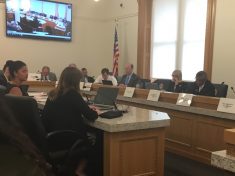
This post was written by Aubrey Hill, a former member of our team.
When we first made the decision to center health equity in our work, there were some major shifts in our approach to policy advocacy. One of those shifts was including housing, food access, and other non-health care legislation in our analysis of health policy. At first, I was pretty intimidated. Every piece of legislation started looking like it had health implications if I squinted hard enough. We didn’t have the time or resources to analyze everything, and each sector has its own jargon to learn and committees to follow. But, I soon learned how to prioritize and navigate our expanded view of health policy and started seeing the patterns racism and other types of discrimination were playing in creating policy winners and losers.
Since the beginning of this country, institutions have been unequal in their treatment of people of color and white people. In fact, there is a pervasive ideology that has been infused throughout our institutions, over generations, rooted in the idea that whites and blacks are inherently unequal and therefore should not be treated equally (dating as far back as founding father, Thomas Jefferson, or further). And, that has resulted in white Coloradans having far more advantages than blacks or Latinos in critical systems of education, economic security, and food access—all of which are major factors in good health. The numbers speak for themselves—our systems don’t work for people of color. Here are just a few examples:
- 28% of black Coloradans and 29% of Latino Coloradans are not graduating from high school, compared to 16% white Coloradans;
- 25% of black Colorado children and 23% of Latino Colorado children live in poverty, compared to 8% of white Colorado children;
- 28% of black Colorado and 17% of Latino high school students went hungry due to a lack of food at home compared to 10% of white Colorado high school students.
These issues are inextricably linked to overall health outcomes and health equity, so they demand our action. This year, we prioritized housing, transportation, and food security as the social determinants of health issues that we would work on in our health policy efforts. Studies have shown that there are substantial and near-immediate improvements in health outcomes when the health care system invests in housing or other social needs of patients. This data has helped convince health care institutions to advocate for legislation they didn’t used to get involved with, such as the Colorado Blueprint to End Hunger, and reallocate their investments to support basic needs of patients. We’re glad to see other health care partners showing interest in ramping up their focus on the social determinants of health, too.
But, we can’t just stop at addressing the social determinants of health—we need to understand and address the underlying reasons some people have good access to healthy food, reliable transportation, and safe neighborhoods, and others don’t. These root causes are the fundamental injustices in our society: racism, classism, sexism, homophobia, and the laws and policies that reinforce and legitimize our discrimination. Changing these systems of oppression is the real work of health equity.
In our graphic novel, Waiting for Health Equity, we dig into these issues and show how our country’s laws and policies, from international trade to criminal justice, have created the health inequities we see today. The more we’re able to reach across sectors and invest resources into issues that influence our health outcomes, the closer to health equity we’ll get. I’m committed to seeking health policy opportunities that accomplish these goals, and I hope you’ll join me. And, if your organization hasn’t yet had a Waiting for Health Equity training, there’s no better time than now!




